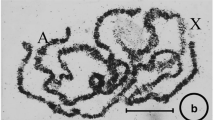Summary
The phenotypes caused by mutations in two autosomal genes of the nematode Caenorhabditis elegans, dpy-21 V and dpy-26 IV, are markedly affected by X chromosome dosage, independent of sexual phenotype. At high X chromosome to autosome ratio, in 2A; 3X animals, these dumpy mutations are lethal; at intermediate ratio, in 2A; 2X animals, they cause dumpiness or lethality; at low ratio, in 2A; 1X animals they cause neither dumpiness nor lethality. One gene, dpy-26, exhibits a strong maternal effect. Interaction between these genes and two major sex-determining genes her-1 V and tra-1 III have been examined. The dumpy mutations partly suppress the masculinization of tra-1 2A;2X animals and also increase the fertility of most her-1 2A;1X hermaphrodites. It is suggested that these dumpy genes are involved in X chromosome dosage compensation, and in some aspects of sexual differentiation. The dpy-26 gene is compared with a similar Drosophila gene, daughterless.
Similar content being viewed by others
References
Baker BS, Ridge KA (1980) Sex and the single cell. I On the action of major loci affecting sex determination in Drosophila melanogaster. Genetics 94:383–423
Baverstock PR, Adams M, Polkinghorne RW, Gelder M (1982) A sex-linked enzyme in birds — Z chromosome conservation but no dosage compensation. Nature 296:763–766
Belote JM, Lucchesi JC (1980) Male specific lethal mutations of Drosophila melanogaster. Genetics 96:165–186
Brenner S (1974) The genetics of Caenorhabditis elegans. Genetics 77:71–94
Cline TW (1979) A male-specific lethal mutation in Drosophila melanogaster that transforms sex. Develop Biol 72:266–275
Cline TW (1981) Maternal and zygotic sex-specific gene interactions in Drosophila melanogaster. Genetics 96:903–926
Hodgkin J (1980) More sex-determination mutants of Caenorhabditis elegans. Genetics 96:649–664
Hodgkin J (1983a) Male phenotypes and mating efficiency in Caenorhabditis elegans. Genetics 103:43–64
Hodgkin J (1983b) Two types of sex determination in a nematode. Nature 304:267–268
Hodgkin JA, Brenner S (1977) Mutations causing transformation of sexual phenotype in the nematode Caenorhabditis elegans. Genetics 86:275–287
Hodgkin J, Horvitz HR, Brenner S (1979) Nondisjunction mutants of the nematode Caenorhabditis elegans. Genetics 91:67–94
Horvitz HR, Brenner S, Hodgkin J, Herman RK (1979) A uniform genetic nomenclature for the nematode Caenorhabditis elegans. Mol Gen Genet 175:129–133
Johnson MS, Turner JRG (1979) Absence of dosage compensation for a sex-linked gene in butterflies (Heliconius). Heredity 43:71–77
Lyon MF (1961) Gene action in the X chromosome of the mouse (Mus musculus L.). Nature 190:372–373
Madl JE, Herman RK (1979) Polyploids and sex determination in Caenorhabditis elegans. Genetics 93:393–402
Meneely PM, Herman RK (1979) Lethals, steriles, and deficiencies in a region of the X chromosome of Caenorhabditis elegans. Genetics 92:99–115
Meneely PM, Herman RK (1981) Suppression and function of X-linked lethal and sterile mutations in Caenorhabditis elegans. Genetics 97:65–84
Meneely PM, Wood WB (1983) An autosomal gene that affects both X-chromosome expression and sex determination in Caenorhabditis elegans. Genetics in press
Moerman DG, Baillie DL (1981) Formaldehyde mutagenesis in the nematode Caenorhabditis elegans. Mut Res 80:273–279
Nelson GA, Lew KK, Ward S (1978) Intersex, a temperature-sensitive mutant of the nematode Caenorhabditis elegans. Dev Biol 66:386–409
Nigon V (1951) Polyploidie experimentale chez un Nematode libre, Rhabditis elegans Maupas. Bull biol Fr Belg 85:187–225
Riddle DL, Swanson MM (1982) The nematode Caenorhabditis elegans. Genetic Maps 2:244–258
Stewart B, Merriam J (1980) Dosage compensation. In: Ashburner M, Wright TRF (eds) The Genetics and Biology of Drosophila. Vol 2d, Academic Press, New York, 107–140
Wills N, Gesteland RF, Karn J, Barnett L, Bolten S, Waterston RH (1983) The genes sup-7 X and sup-5 III suppress amber nonsense mutations via altered transfer RNA. Cell 33:575–583
White MJD (1973) Animal Cytology and Evolution. Cambridge University Press
Wood WB, Hecht R, Carr S, Vanderslice R, Wolf N, Hirsh D (1980) Parental effects and phenotypic characterization of mutations that affect early development in Caenorhabditis elegans. Develop Biol 74:446–469
Author information
Authors and Affiliations
Additional information
Communicated by W. Gehring
Rights and permissions
About this article
Cite this article
Hodgkin, J. X chromosome dosage and gene expression in Caenorhabditis elegans: Two unusual dumpy genes. Mol Gen Genet 192, 452–458 (1983). https://doi.org/10.1007/BF00392190
Received:
Issue Date:
DOI: https://doi.org/10.1007/BF00392190




